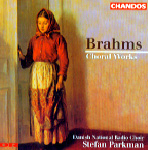It’s not easy to record Brahms’ a cappella choral music. At least that’s the impression you get from hearing this and every other recording of the Op. 42 and Op. 104 sets. Not that there are many to choose from: for some reason–perhaps their high degree of difficulty–these ultra-romantic settings of some of the 19th century’s most evocative poetry, fraught with mythical imagery (Op. 42) and more nostalgic themes such as love’s despair, departing summer, and lost youth (Op. 104)–are rarely tackled even by today’s most accomplished choirs. The relatively dense textures–scored for up to six parts–and relentlessly rich harmonic structures tend to saturate the air like 100 percent humidity in summer. And that’s what happens in these otherwise assured performances by the very fine and well-rehearsed Danish Radio Choir. It’s really no one’s fault, but if you hear these pieces live you get a much clearer and more satisfying impression of how the music really sounds. (Nevertheless, works such as Nachtwache I and II and Im Herbst are masterpieces by any definition.)
The accompanied works are another story. Brahms gives more room for the instruments and voices to “breathe” in the Op. 17 pieces for female voices with two horns and harp; and in the Ziguenerlieder, Brahms’ brilliantly imagined, alluring, consummately colorful “gypsy songs”, the melodies dominate the scene, recalling both the refinement of the Liebeslieder waltzes and the abandon of some of Brahms’ dance-inspired violin and piano works. Again, however, in this recording the acoustic gets the better of the music, especially in the Zigeunerlieder, which are simply too resonant, with the chorus too far back when it should be front and center. Conductor and chorus add some charming personal interpretive touches here, but when compared to the more immediate, technically polished, and successfully balanced version by the RIAS-Kammerchor (Harmonia Mundi), this Danish effort, as obviously heartfelt and energetic as it is, falls short.
































